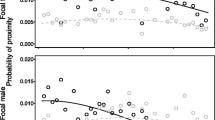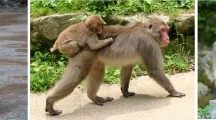Abstract
The behavioral interactions of 22 infant and mother Japanese macaques with other group members were studied. Focal-animal observations were made from the time of each infant’s birth until 1 year of age. Infants and mothers both displayed exceedingly strong preferences for associating with matrilineal kin and, specifically, for female kin. The degree of genetic relatedness was positively correlated with levels of spatial proximity, contact, grooming, aggression, and play. Overall frequencies of interactions with nonkin were very low, and partner sex was not an important factor in interactions with nonkin. There were no significant differences between male and female infants in interactions with kin versus nonkin. There was only one significant difference between male and female infants in interactions with males versus females: female infants showed stronger preferences for initiating proximity with females over males than did male infants. Because mothers provide the focal point for infant interactions during the first year of life, we compared the behavior of infants and mothers. Mothers were the recipients of more social interactions than were infants, mothers engaged in more grooming than did infants, and infants engaged in more social play than did mothers. These findings are only partially consistent with kin-selection theory, and the inadequacies of studying matrilineal kin discrimination to test kin selection are reviewed. The near-absence of infant sex differences in associations with social partners suggests that although maternal kin other than the mother are important to infant socialization, they probably do not contribute to the development of behavioral sex differences until after the first year of life.
Similar content being viewed by others
References
Alexander, B. K., and Bowers, J. M. (1969). Social organization of a troop of Japanese monkeys in a 2-acre enclosure.Folia primatol. 2: 230–242.
Eaton, G. G. (1976). The social order of Japanese macaques.Sci. Am. 235: 96–106.
Eaton, G. G. (1978). Longitudinal studies of sexual behavior in the Oregon troop of Japanese macaques. In McGill, T. E., Dewsbury, D. A., and Sachs, B. D. (eds.),Sex and Behavior: Status and Prospectus, Plenum Press, New York.
Eaton, G. G., Johnson, D. F., Glick, B. B., and Worlein, J. (1985). Development in Japanese macaques (Macaca fuscata): Sexually dimorphic behavior during the first year of life.Primates 26: 238–248.
Enomoto, T. (1974). The sexual behavior of Japanese monkeys.J. hum. Evol. 3: 351–372.
Enomoto, T. (1978). On social preference in sexual behavior of Japanese monkeys (Macaca fuscata).J. hum. Evol. 7: 283–293.
Grewal, B. S. (1980). Social relationships between adult central males and kinship groups of Japanese monkeys at Arashiyama with some aspects of troop organization.Primates 21: 161–180.
Hamilton, W. D. (1964). The evolution of social behavior.J. theor. Biol. 7: 1–51.
Imanishi, K. (1961). The origin of the human family—a primatological approach.Jap. J. Ethnol. 25: 119–130.
Itani, J., and Nishimura, A. (1973). The study of infrahuman culture in Japan. A review. In Menzel, E. W., Jr. (ed.),Symposia of the 4th International Congress of Primatology, Vol. 1, Karger, Basel.
Itoigawa, N. (1973). Group organization of a natural troop of Japanese monkeys and mother-infant interactions. In Carpenter, C. R. (ed.),Behavioral Regulators of Behavior in Primates, Bucknell University Press, Lewisburg, Pa., pp. 229–250.
Kawai, M. (1965). On the system of social ranks in a natural troop of Japanese monkeys: (I) Basic rank and dependent rank. In Altmann, S. A. (ed.),Japanese Monkeys: A Collection of Translations, University of Alberta, Edmonton.
Kawamura, S. (1965). Matriarchal social ranks in the Minoo-B troop: A study of the rank system of Japanese monkeys. In Altmann, S. A. (ed.),Japanese Monkeys: A Collection of Translations, University of Alberta, Edmonton.
Koyama, N. (1967). On dominance rank and kinship of a wild Japanese monkey troop in Arashiyama.Primates 8: 189–216.
Koyama, N. (1970). Changes in dominance rank and division of a wild Japanese monkey troop in Arashiyama.Primates 11: 355–390.
Kurland, J. A. (1977). Kin selection in the Japanese monkey. In Szalay, F. S. (ed.),Contributions to Primatology, Vol. 12, Karger, Basel.
Nishida, T. (1966). A sociological study of solitary male monkeys.Primates 7: 141–204.
Norikoshi, K. (1974). The development of peer-mate relationships in Japanese macaque infants.Primates 15: 39–46.
Poirier, F. E. (1977). Introduction. In Chevalier-Skolnikoff, S., and Poirier, F. E. (eds.),Primate Biosocial Development: Biological, Social and Ecological Determinants, Garland, New York.
Sokal, R. R., and Rolf, F. J. (1973).Introduction to Biostatistics, W. H. Freeman, San Francisco.
Sugiyama, Y. (1976). Life history of male Japanese monkeys. In Rosenblatt, J. S., Hinde, R. A., Shaw, E., and Beer, C. (eds.),Advances in the Study of Behavior, Vol. 7, Academic Press, New York.
Tokuda, K. (1961-1962). A study on the sexual behavior in a Japanese monkey troop.Primates 3: 1–40.
Watanabe, K. (1979). Alliance formation in a free-ranging troop of Japanese monkeys.Primates 20: 459–474.
Winer, B. J. (1962).Statistical Principles in Experimental Design, McGraw-Hill, New York.
Yamada, M. (1963). A study of blood-relationship in the natural society of the Japanese macaque.Primates 4: 43–66.
Author information
Authors and Affiliations
Rights and permissions
About this article
Cite this article
Glide, B.B., Eaton, G.G., Johnson, D.F. et al. Social behavior of infant and mother Japanese Macaques (Macaca fuscata): Effects of kinship, partner sex, and infant sex. Int J Primatol 7, 139–155 (1986). https://doi.org/10.1007/BF02692315
Received:
Revised:
Issue Date:
DOI: https://doi.org/10.1007/BF02692315




